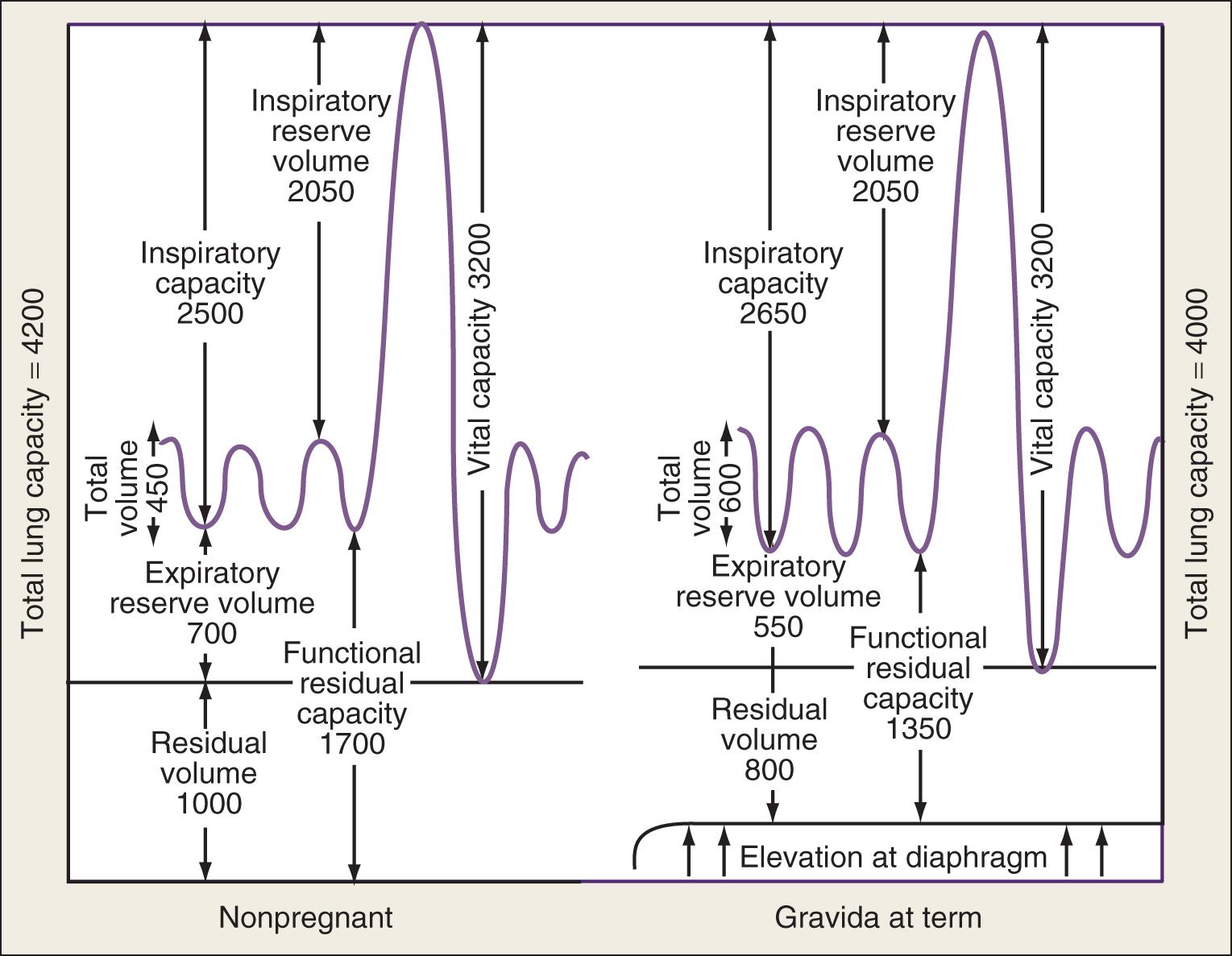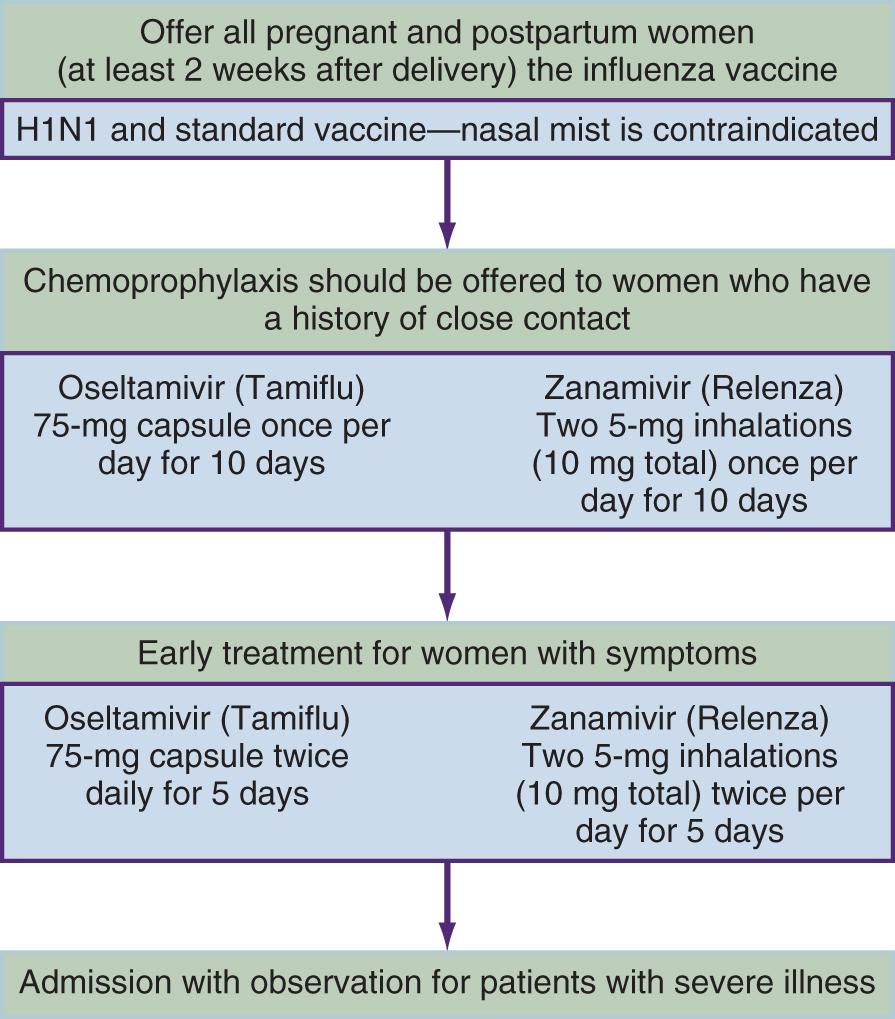Physical Address
304 North Cardinal St.
Dorchester Center, MA 02124
During pregnancy, the respiratory system undergoes a number of changes and is subject to functional and anatomic stresses. The critical care provider must remember these changes to appropriately care for the maternal-fetal unit. Although the need for ventilatory support is rare in pregnancy, respiratory insufficiency, which may complicate up to 1 in 500 pregnancies, is still the most common indication in pregnancy for admission to a critical care unit.
In this chapter, the unique physiologic changes that occur during pregnancy are addressed and guidance is provided to critical care specialists who may encounter pregnancies that are complicated by acute pulmonary complications.
A number of physiologic changes affect respiration during pregnancy. Normal pregnancy is associated with a 20% increase in oxygen consumption and a 15% increase in metabolic rate. During the first trimester, minute ventilation is increased, whereas the respiratory rate remains the same. Although one might assume that the lung volume during pregnancy would decrease owing to a rise in the maternal diaphragm, the tidal volume (V t ) is actually increased by 40% over baseline values. The increase in V t is thought to be caused by the increase in circulating progesterone that affects the respiratory center. Arterial blood gas measurements reflect respiratory alkalosis compensated for by metabolic acidosis that results in a relatively normal pH. PaCO 2 usually ranges from 28 to 32 mm Hg. Functional residual capacity (FRC), residual volume, and total lung volume are decreased near term. Because of this decrease, respiratory distress occurs more rapidly in the gravid than in the nongravid state. The function of the large airways, as measured by forced expiratory volume in 1 second (FEV 1 ) and peak expiratory flow rate (PEFR), is essentially unchanged throughout pregnancy. Oxygen consumption reaches 20%–33% above baseline by the third trimester. Airway hyperemia and edema occur during pregnancy as a result for human placental growth hormone, resulting in the possibility of a difficult or failed intubation.
Colloid osmotic pressure is decreased by 20%. This change in hydrostatic pressure results in a propensity for pregnant patients to develop cardiogenic and noncardiogenic pulmonary edema.
Dyspnea on exertion is common, especially in the third trimester of pregnancy, making the diagnosis of respiratory problems more difficult than that in the nongravid state.
Fig. 133.1 illustrates the graphic relationship of pulmonary changes.

Asthma is one of the most common pulmonary problems in pregnant women; recent studies have reported that approximately 8% are affected. The disease is characterized by hyperactive airways, leading to episodic bronchoconstriction. The role of inflammatory mediators in the pathogenesis of asthma has become apparent in recent years, leading to the early use of antiinflammatory medications in the treatment of exacerbations.
Asthma may be triggered by environmental allergens, medications—especially aspirin or nonsteroidal antiinflammatory drugs (NSAIDs)—or stress. Most exacerbations are marked by cough, wheezing, and dyspnea. Rapid therapeutic intervention at the time of an exacerbation is imperative to prevent impaired maternal and fetal oxygenation because uncontrolled asthma can increase maternal morbidity. In several studies, even after controlling for confounding variables, adverse pregnancy outcomes are more pronounced in patients with asthma. These include low birth weight, preeclampsia, preterm birth, and stillbirth. , Although historical data have shown an increase in death and low birth weight, Fitzsimmons and colleagues observed low birth weight in only those patients treated for status asthmaticus. In addition, Schatz and colleagues noted that intrauterine growth restriction was directedly related to lung function as measured by FEV 1 .
However, a recent meta-analysis of 40 studies demonstrated that maternal asthma is associated with an increase in low-birth-weight infants, intrauterine growth restriction, preterm delivery, and preeclampsia when controlled for all variables.
Numerous studies have observed that the course of asthma may be affected by pregnancy. Gluck and colleagues found that, on average, asthma improved in 36% of women during pregnancy, remained unchanged in 41%, and worsened in 23%. Schatz and colleagues, in an analysis of 366 pregnancies in which patient status was followed by objective criteria, found that asthma improved in 28% of women, remained unchanged in 33%, and worsened in 35%. Fifty-nine percent of the patients had similar asthma control in successive pregnancies. Asthma exacerbations are not uniformly distributed in pregnancy. Observational studies have found that exacerbations were most frequent before 24 weeks’ gestation.
Fetal sex may influence asthma in pregnancy. In one study, mothers who gave birth to boys were more likely to report improved asthma symptoms. Dodds and colleagues found that the use of medications to treat asthma was less common in mothers of boys. Although a number of hypotheses have been proposed, including alterations in progesterone levels and the role of leukotrienes, changes in not one of these mediators can explain the varied course of pregnant asthmatics.
The National Asthma Education and Prevention Program issued specific guidelines regarding asthma treatment. In 1993 the Working Group on Asthma and Pregnancy established criteria for diagnosis and treatment among the gravid population ( Fig. 133.2 ).

The goals of treatment during pregnancy are to control exacerbation and prevent status asthmaticus, thereby reducing maternal and fetal hypoxemia. The initial step in treatment involves monitoring pulmonary function, and FEV 1 is the single best measure. A physical examination and chest radiography are poor measures of disease severity. A portable handheld peak flow meter gives a quick, accurate assessment by measuring PEFR. Most authorities believe that airways remain essentially unchanged throughout pregnancy; therefore every patient with asthma should be given a peak flow meter and be educated in its use. The patient should obtain a baseline PEFR during a quiescent period. The severity of disease is determined by the occurrences of exacerbations and changes in FEV 1 and PEFR. The PEFR can be used as a guide to refer the patient for emergency care.
Pharmacologic therapy is the mainstay of asthma treatment. Most drugs used in the treatment of asthma are thought to be safe in pregnancy. Inhaled beta-agonists are the most frequently used in asthma treatment. A prospective study of inhaled beta-agonists in 259 pregnancies showed no change in the rate of congenital malformation, perinatal mortality, low birth weight, or complications of pregnancy. There is little role for the use of oral beta-agonists, which may cause more adverse systemic symptoms and are not more effective than inhaled drugs.
Inhaled corticosteroid therapy remains the mainstay of antiinflammatory treatment of asthma. Corticosteroids have also been advocated as first-line therapy in patients with mild asthma. Studies have demonstrated that with asthma, those taking an inhaled corticosteroid were four times less likely than their nontreated counterparts to suffer an exacerbation. Another randomized study noted that there was a 55% reduction in readmission rates because of acute asthma in patients using inhaled beclomethasone. Inhaled corticosteroids can increase the effectiveness of beta-adrenergic agents by inducing the formation of new beta receptors. Because beclomethasone is the most studied of the inhaled corticosteroids in pregnancy, it is recommended as first-line therapy. However, if patients are well controlled on other corticosteroid preparations, it is suggested they be continued on their current medication because all inhaled corticosteroids are labeled by the US Food and Drug Administration (FDA) as pregnancy class C. Other antiinflammatory medications used in the treatment of asthma (e.g., cromolyn sodium and nedocromil sodium) appear to be less effective than inhaled corticosteroids in reducing symptoms.
Systemic corticosteroids should be reserved for the periodic treatment of acute asthma exacerbations. Chronic oral corticosteroid therapy may increase the risks of gestational diabetes mellitus, preterm labor, low-birth-weight infants, and preeclampsia; however, it is evident that the benefits of controlled severe asthma outweigh the potential risks to the mother and fetus.
Intravenous corticosteroids have no increased benefits over oral corticosteroids in the treatment of acute exacerbations. Methylprednisolone, hydrocortisone, and prednisone are safe for use in pregnancy, unlike betamethasone or dexamethasone, because very little active drug crosses the placenta.
Leukotriene pathway moderators have been shown to improve pulmonary function, as measured by FEV 1 . Zafirlukast and montelukast are rated as FDA category B; however, these drugs have not been frequently used in pregnancy, and their role is undetermined.
The treatment of asthma requires providing patient education in the preconceptional period and during the pregnancy for optimum outcome. Box 133.1 shows a suggested schematic for the treatment of asthma in pregnancy.
Become a Clinical Tree membership for Full access and enjoy Unlimited articles
If you are a member. Log in here